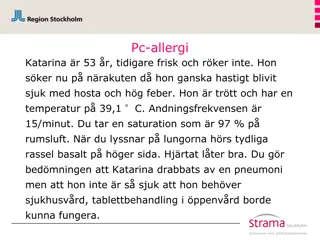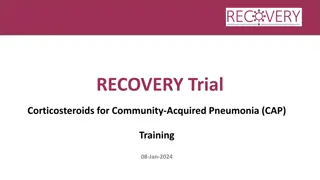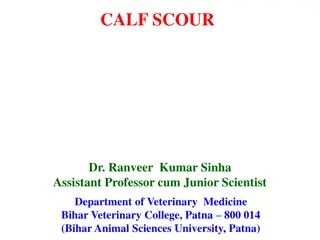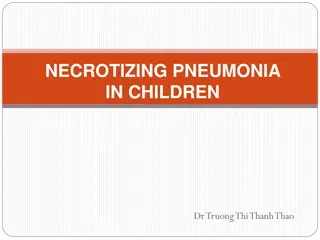Understanding Calf Pneumonia: Symptoms, Treatment, and Consequences
Calf pneumonia is a significant disease in calves aged one to five months. It is essential to diagnose, treat, and prevent this multifactorial disease for the cattle industry. With types, causes, symptoms, and consequences discussed in detail, the content also covers treatment options like antibiotics for managing calf pneumonia effectively.
Download Presentation

Please find below an Image/Link to download the presentation.
The content on the website is provided AS IS for your information and personal use only. It may not be sold, licensed, or shared on other websites without obtaining consent from the author. Download presentation by click this link. If you encounter any issues during the download, it is possible that the publisher has removed the file from their server.
E N D
Presentation Transcript
CALF PNEUMONIA Dr. Ranveer Kumar Sinha Assistant Professor cum Junior Scientist Department of Veterinary Medicine Bihar Veterinary College, Patna 800 014 (Bihar Animal Sciences University, Patna)
CALF PNEUMONIA Calf pneumonia is a Important calf diseases Diagnosing, treating and preventing this diseases is very important for every cattle industry. It is a multifactorial disease and most common in calves between one to five months of age.
TYPES of CALF PNEUMONIA Chronic Pneumonia: It is more gradual in nature with no distinct ill phase & animal still eat but have a slight nasal discharge with an increased respiratory rate and cough. Acute Pneumonia: It is usually more sudden in onset.
CAUSES OF CALF PNEUMONIA Environmental Factors: Low environmental temperature High Humidity Poor Ventilation Infectious Agents: Viral -Bovine Respiratory syncytial Virus (RSV) Bacterial Parasitic Mycoplasma
SYMPTOM OF CALF PNEUMONIA By auscultation of the anterior ventral lung crackles and wheezes & an increase in bronchial sounds especially on inspiration. Dull and depressed High temperature Raised breathing due to lung damage Nasal discharge Coughing Reduced food intake Weight Loss
CONSEQUENCES OF PNEUMONIA Short-term consequences: Reduced dry matter intake, delayed weaning and higher risk of an additional pneumonia event at weaning. Long-term Consequences: Delayed breeding, higher age at first calving and compromised milk production.
Treatment of calf pneumonia Removal of primary etiology: Antibiotics: Enrofloxacine Marboflxacine Cephalosporion . Sulfa &Trimethoprime Antihelmintics: Anti-inflammatory (St & Non St): SupportiveTreatment: Injection of vitamin C and A to increase body immunity Mucolytics & Bronchodilator Antihistaminic Correct anemia if present. Easily digestible and palatable food
PREVENTION OF CALF PNEUMONIA Removal of the cause of diseases Clean environment Proper ventilation. If ammonia can be smelled it is a sign of poor ventilation. Swabbing of the navel with tincture iodine Removal of the newborn from the infected environment Feeding calves inadequately will reduce calf growth and their immune system response which helps fight diseases. Ingestion of colostrums from dam within four to six hours of birth to receive adequate immunity. Special nutritional and housing requirements. Isolation of newborn calf in calf rearing unit within few days after birth.























